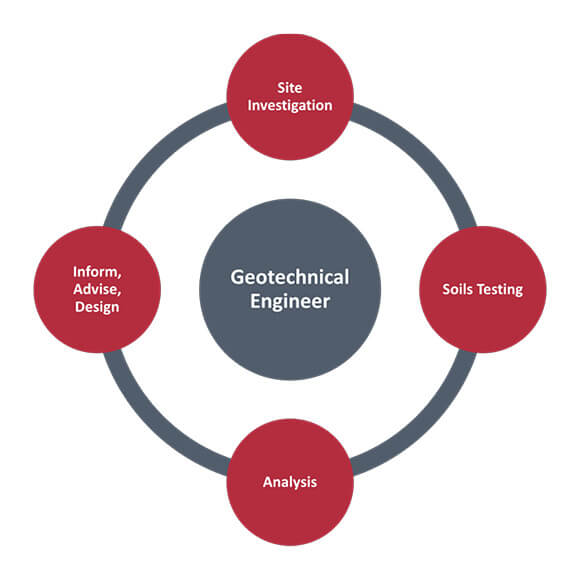The Definitive Guide for Geotheta
The Definitive Guide for Geotheta
Blog Article
7 Simple Techniques For Geotheta
Table of ContentsAn Unbiased View of GeothetaThe Ultimate Guide To GeothetaThe Buzz on GeothetaThe Basic Principles Of Geotheta
They team up with civil engineers, architectural designers, engineers, and various other specialists to integrate geotechnical considerations into the total job layout and building procedure. This requires efficient synergy, sychronisation, and interaction to make certain that the geotechnical aspects align with the job objectives and meet governing needs.Mining & Materials Engineering: Concepts of boring, infiltration rates, and variables influencing the option of exploration method. Features of nitroglycerins, firing systems and blast patterns. Blasting methods in surface and below ground functions. Unique blasting strategies at excavation borders. Resonance and sound control. Mechanical and constant techniques to fragmentation, including longwall shearing and fullface boring.
Modelling of piece and fragment dimension distributions; comminution as a transfer function. Comminution innovation: crushing, grinding, dimension classification. Integrated evaluation of fragmentation and comminution procedures. Supplied by: Mining & Products Design.
Fascination About Geotheta
Bachelor's degree programs in civil, geotechnical, geological, and environmental engineering normally last four years and consist of basic education and learning programs in English, social scientific research, and the liberal arts, in addition to programs in innovative maths, structural geology, and liquid mineralogy. (https://www.4shared.com/u/w_sNL5Rc/ianhammond2191.html)
Geotechnical engineering entails the analysis of the dirt and rock conditions at a certain website, and their effects for the growth of that website. As a lot of structures count on the ground for assistance, it lacks shock that a thorough understanding of the ground conditions, and the suitability of foundation systems, are crucial to the lasting stability and performance of the structure or framework.
Specialising in the examination of geological formations and ground practices, geotechnical designers do scientific examinations and testing to understand the effect these geological developments may carry the layout and building of building, civil and framework jobs. This knowledge is critical for the layout and building and construction of buildings, roads, passages, dams, bridges, and water supply and sewage systems.
The geotechnical team at Douglas Partners regularly seek advice from with architects, style engineers, designers, and home builders to make suggestions on layout and advancement propositions to make sure that the built structures are accordingly developed for the ground conditions. The layout of footing systems needs to take into consideration the weight of the framework, the capacity of the ground to support that weight with each other with motion tolerances and effective building and construction.
Geotheta Fundamentals Explained
This job is substantially streamlined by the use our Douglas Map geospatial platform that makes this information conveniently available in an easy to utilize internet internet browser user interface. A geotechnical engineer will route the exploration of boreholes and examination pits to accumulate dirt and other examples, and additionally evaluate surface functions and ground direct exposures to form a geotechnical model of the subsurface conditions.
Depending upon the job kind and ground problems encountered, lab screening might to name a few points evaluate toughness, compressibility, reactivity and/or permeability of soil and rock samples. After this data is collected and collated, the results are utilized for a geotechnical model of the site, which is usually presented as sections throughout the website.

A geotechnical investigation by nature can just analyze the ground conditions at the locations drilled or excavated. Natural variants in soil and rock conditions can take place throughout a website and in between test areas. It is as a result great practice that the geotechnical engineer be retained throughout construction of the job to offer on-site confirmation that the ground conditions experienced follow the assumptions and recommendations provided in the geotechnical examination record.
All About Geotheta
Geotechnical designers use their extensive knowledge of dirt and rock to analyze risk and solve problems on varied facilities projectsGeotechnical design is a specialist branch of civil design which takes a look at the practices of planet materials and the application of dirt and rock auto mechanics. Geo Tech Engineer. As a geotechnical engineer, you will certainly examine the physical, mechanical and chemical homes of dirt and rock in order to design structures, keeping frameworks and earthworks
Geotechnical engineering is carefully connected to and overlaps with, both engineering geology and ground engineering - https://www.tripadvisor.in/Profile/geotheta1. It's possible to specialise in geotechnics or benefit a geotechnical company however be referred to as an engineering geologist or a ground engineer. As a geotechnical designer, you'll need to: develop and keep partnerships with clients and various other specialists involved in the website, throughout each projectmaintain safety and security criteria on website be conscious of price ramifications when you make recommendationsstudy geological maps and aerial photographs from a range of resources and from different time periodsexamine construction intends to see just how practical they are based on your understanding of the siteinvestigate threats or geological risks for the sitesearch for environmentally delicate functions, such as land fill begin to establish accurate and expository ground modelsplan field investigationsdrill and evaluate examples of bedrock, dirt, groundwater and added products supervise various other specialists on sitesolve technological concerns as they occur, such as unanticipated structures at drill sitesmonitor conditions during and after building and construction to make certain frameworks are secure in the short and long termadding information gathered on website to your preliminary researchcreating geotechnical computations, illustrations, and 2 or three-dimensional computer system models interpreting the datamaking referrals like this regarding the proposed use the website

Report this page